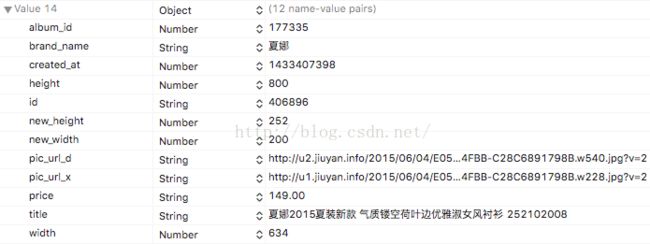Swift UITableView瀑布流/NSURLConnection异步网络请求
去年写过一个OC版本的瀑布流Demo 《【iOS】UITableView实现的瀑布流效果》 。
接触Swift一段时间了,今天就是用Swift再写了一个瀑布流的Demo。原理是一样的这里不再赘述。在写这个Demo的过程中是用到了NSURLConnection的异步网络请求和GCD做了一个图片的异步加载,没有做图片的缓存,所以是用起来有些卡。cell是带左滑删除视图的,删除功能是没有实现的。
效果图:
Demo工作流程:
1.制作三个tableiView
2.网络请求,获取图片数据模型(title和url等)
3.数据封装成模型
4.reload tableView
图片数据模型
代码:
PICModel.swift
import UIKit
class PICModel: NSObject {
var album_id : NSNumber?
var brand_name : String?
var created_at : NSNumber?
var height : NSNumber?
var id : String?
var new_height : NSNumber?
var new_width : NSNumber?
var pic_url_d : String?
var pic_url_x : String?
var price : String?
var title : String?
var width : NSNumber?
}ViewController.swift
//
// ViewController.swift
// 瀑布流-Swift
//
// Created by zhuming on 16/3/29.
// Copyright © 2016年 zhuming. All rights reserved.
//
import UIKit
class ViewController: UIViewController, UITableViewDelegate, UITableViewDataSource,UIAlertViewDelegate{
var tableView1 : UITableView?
var tableView2 : UITableView?
var tableView3 : UITableView?
var indexPath : NSIndexPath?
var menbers1 = [NSDictionary]()
var menbers2 = [NSDictionary]()
var menbers3 = [NSDictionary]()
var PICModelArray1 = [PICModel]()
var PICModelArray2 = [PICModel]()
var PICModelArray3 = [PICModel]()
var dataArray = ["1","2","3","4","5","6","7","8","9","10","11","12"]
let urlString1 = "http://itugo.com/client/ios/api/getpiclist?_version=20140117.2.5.1&_req_from=oc&_source=ios&type=&_uuid=efe47094e00109db8c28cf0ae9b607b9&max=&tag=&_promotion_channel=App%20Store&_platform=iPhone&sort=new&from=tag&_uiid=2FF998CF0D2A40E7AF6F8FAFB8F57538&_net=wifi&min=0";
let urlString2 = "http://itugo.com/client/ios/api/getpiclist?_version=20140117.2.5.1&_req_from=oc&_source=ios&type=accessary&_uuid=efe47094e00109db8c28cf0ae9b607b9&max=&tag=&_promotion_channel=App%20Store&_platform=iPhone&sort=new&from=tag&_uiid=2FF998CF0D2A40E7AF6F8FAFB8F57538&_net=wifi&min=0";
let urlString3 = "http://itugo.com/client/ios/api/getpiclist?_version=20140117.2.5.1&_req_from=oc&_source=ios&type=shoes&_uuid=efe47094e00109db8c28cf0ae9b607b9&max=&tag=&_promotion_channel=App%20Store&_platform=iPhone&sort=new&from=tag&_uiid=2FF998CF0D2A40E7AF6F8FAFB8F57538&_net=wifi&min=0";
override func viewDidLoad() {
super.viewDidLoad()
self.initTableView()
self.requestData(urlString1)
self.requestData(urlString2)
self.requestData(urlString3)
// Do any additional setup after loading the view, typically from a nib.
}
/**
初始化表格
*/
func initTableView() {
self.tableView1 = UITableView.init(frame: CGRectMake(5, 20, 100, 548))
self.tableView1!.delegate = self
self.tableView1!.dataSource = self;
self.tableView1?.showsVerticalScrollIndicator = false
self.tableView1!.registerNib(UINib(nibName:"PBTableViewCell", bundle:nil),
forCellReuseIdentifier:"PBTableViewCell")
self.view .addSubview(self.tableView1!)
self.tableView2 = UITableView.init(frame: CGRectMake(110, 20, 100, 548))
self.tableView2!.delegate = self
self.tableView2!.dataSource = self;
self.tableView2?.showsVerticalScrollIndicator = false
self.tableView2!.registerNib(UINib(nibName:"PBTableViewCell", bundle:nil),
forCellReuseIdentifier:"PBTableViewCell")
self.view .addSubview(self.tableView2!)
self.tableView3 = UITableView.init(frame: CGRectMake(215, 20, 100, 548))
self.tableView3!.delegate = self
self.tableView3!.dataSource = self;
self.tableView3?.showsVerticalScrollIndicator = false
self.tableView3!.registerNib(UINib(nibName:"PBTableViewCell", bundle:nil),
forCellReuseIdentifier:"PBTableViewCell")
self.view .addSubview(self.tableView3!)
}
// 网络请求数据
func requestData(urlString : String){
let url = NSURL(string: urlString)
let request = NSURLRequest(URL: url!)
NSURLConnection.sendAsynchronousRequest(request, queue: NSOperationQueue.mainQueue()) { (response:NSURLResponse?, data:NSData?, error:NSError?) in
let jsonResult:NSDictionary = try! NSJSONSerialization.JSONObjectWithData(data!, options: NSJSONReadingOptions.MutableContainers) as! NSDictionary
let dice:NSDictionary = (jsonResult["data"] as? NSDictionary)!
if (url!.isEqual(NSURL(string: self.urlString1))){
self.menbers1 = dice["data"] as! Array
print("self.menbers = \(self.menbers1.count)")
for value in self.menbers1{
let dice:NSDictionary = value
self.PICModelArray1.append(self .makePICModel(dice))
}
print("PICModelArray = \(self.PICModelArray1.count)")
self.tableView1?.reloadData()
}
if (url!.isEqual(NSURL(string: self.urlString2))){
self.menbers2 = dice["data"] as! Array
print("self.menbers = \(self.menbers2.count)")
for value in self.menbers2{
let dice:NSDictionary = value
self.PICModelArray2.append(self .makePICModel(dice))
}
print("PICModelArray = \(self.PICModelArray2.count)")
self.tableView2?.reloadData()
}
if (url!.isEqual(NSURL(string: self.urlString3))){
self.menbers3 = dice["data"] as! Array
print("self.menbers = \(self.menbers3.count)")
for value in self.menbers3{
let dice:NSDictionary = value
self.PICModelArray3.append(self .makePICModel(dice))
}
print("PICModelArray = \(self.PICModelArray3.count)")
self.tableView3?.reloadData()
}
}
}
// 数据封装成模型
func makePICModel(dice : NSDictionary) -> PICModel{
let model = PICModel.init()
model.album_id = dice["album_id"] as? NSNumber
model.brand_name = dice["brand_name"] as? String
model.created_at = dice["created_at"] as? NSNumber
model.height = dice["height"] as? NSNumber
model.id = dice["id"] as? String
model.new_height = dice["new_height"] as? NSNumber
model.new_width = dice["new_width"] as? NSNumber
model.pic_url_d = dice["pic_url_d"] as? String
model.pic_url_x = dice["pic_url_x"] as? String
model.price = dice["price"] as? String
model.title = dice["title"] as? String
model.width = dice["width"] as? NSNumber
return model
}
// UITableViewDelegate, UITableViewDataSource
func tableView(tableView: UITableView, numberOfRowsInSection section: Int) -> Int {
if tableView.isEqual(self.tableView1) {
return self.PICModelArray1.count
}
if tableView.isEqual(self.tableView2) {
return self.PICModelArray2.count
}
if tableView.isEqual(self.tableView3) {
return self.PICModelArray3.count
}
return 10;
}
func numberOfSectionsInTableView(tableView: UITableView) -> Int {
return 1;
}
// 设置cell的高度
func tableView(tableView: UITableView, heightForRowAtIndexPath indexPath: NSIndexPath) -> CGFloat {
if tableView.isEqual(self.tableView1) {
let model = self.PICModelArray1[indexPath.row] as PICModel
let height = model.new_height as! CGFloat
return height*0.5
}
if tableView.isEqual(self.tableView2) {
let model = self.PICModelArray2[indexPath.row] as PICModel
let height = model.new_height as! CGFloat
return height*0.5
}
if tableView.isEqual(self.tableView3) {
let model = self.PICModelArray3[indexPath.row] as PICModel
let height = model.new_height as! CGFloat
return height*0.5
}
return 10;
}
func tableView(tableView: UITableView, cellForRowAtIndexPath indexPath: NSIndexPath) -> UITableViewCell {
let identify:String = "PBTableViewCell"
let cell:PBTableViewCell = tableView.dequeueReusableCellWithIdentifier(identify)
as! PBTableViewCell
cell.selectionStyle = UITableViewCellSelectionStyle.None
var model:PICModel!
if tableView.isEqual(self.tableView1) {
model = self.PICModelArray1[indexPath.row] as PICModel
}
if tableView.isEqual(self.tableView2) {
model = self.PICModelArray2[indexPath.row] as PICModel
}
if tableView.isEqual(self.tableView3) {
model = self.PICModelArray3[indexPath.row] as PICModel
}
cell.titleLabel?.text = model.title
// 异步加载图片
dispatch_async(dispatch_get_global_queue(DISPATCH_QUEUE_PRIORITY_DEFAULT, 0)) {
let data = NSData.init(contentsOfURL: NSURL(string: model.pic_url_x!)!)
dispatch_async(dispatch_get_main_queue(), {
cell.backImageView?.image = UIImage.init(data: data!)
})
}
return cell
}
// 三个TableView 关联滚动
func scrollViewDidScroll(scrollView: UIScrollView) {
if scrollView.isEqual(self.tableView1) {
self.tableView2?.setContentOffset((self.tableView1?.contentOffset)!, animated: false)
self.tableView3?.setContentOffset((self.tableView1?.contentOffset)!, animated: false)
}
if scrollView.isEqual(self.tableView2) {
self.tableView1?.setContentOffset((self.tableView2?.contentOffset)!, animated: false)
self.tableView3?.setContentOffset((self.tableView2?.contentOffset)!, animated: false)
}
if scrollView.isEqual(self.tableView3) {
self.tableView1?.setContentOffset((self.tableView3?.contentOffset)!, animated: false)
self.tableView2?.setContentOffset((self.tableView3?.contentOffset)!, animated: false)
}
}
func tableView(tableView: UITableView, didSelectRowAtIndexPath indexPath: NSIndexPath) {
print("row = \(indexPath.row)")
}
func tableView(tableView: UITableView, titleForDeleteConfirmationButtonForRowAtIndexPath indexPath: NSIndexPath) -> String? {
return "删除"
}
func tableView(tableView: UITableView, commitEditingStyle editingStyle: UITableViewCellEditingStyle, forRowAtIndexPath indexPath: NSIndexPath){
self.indexPath = indexPath
self.showAlView(indexPath)
}
// UIAlertView的使用
func showAlView(indexPath :NSIndexPath){
let alert = UIAlertView.init(title: "警告", message: "确定删除第\(indexPath.row + 1)行", delegate: self, cancelButtonTitle: "取消", otherButtonTitles: "确定")
alert.show()
}
func alertView(alertView: UIAlertView, clickedButtonAtIndex buttonIndex: Int) {
if (buttonIndex == 0) {
NSLog("取消");
}
else{
NSLog("删除\(self.indexPath!.row)")
}
}
override func didReceiveMemoryWarning() {
super.didReceiveMemoryWarning()
// Dispose of any resources that can be recreated.
}
}
写在最后:
可能是写的Swift的代码写少了,感觉写起来没有OC顺手,然后自己慢慢体会……O(∩_∩)O哈哈~
github代码地址:请点击我
